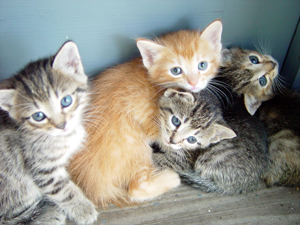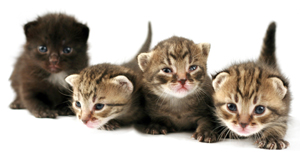How to Care for Orphan Kittens
NOTE: This advice is in no way meant to replace the advice from your veterinarian. Please consult your veterinarian as soon as possible to determine the best care for your orphan kitten.
You're on your nightly walk when you hear that heart-stopping sound—the soft chorusing mews of a kitten. With some investigation, you determine it's without a mother and bring the kitten home. Now what?
• Determine the age of the kitten to see if it needs to be bottle fed or if it can go directly to soft food. If the kitten's eyes are closed, ears folded over: it's in the vicinity of 1 to 14 days old. Eyes open, kitten moves but is wobbly: it's about 2-3 weeks old. Eyes open, ears up, can walk around: it's approximately 3 weeks or older.
• If the kitten is cold, warm it slowly by holding it against your bare skin, allowing it to absorb your body heat. Do not submerge it in water or do any other drastic warming measure. Simply wrapping the kitten up in a blanket or towel is usually not sufficient as it is not able to generate its own heat. The kitten needs to absorb heat from you. Do not attempt to feed a cold kitten; wait until it warms up.
• Make a kitten box— put a heating pad in a box large enough to accommodate the heating pad plus more room so the kitten can crawl off if it gets too warm. Cover the heating pad with several towels. Do not lay the kitten directly on the heating pad. Set the temperature to low. Change the towels two to three times daily.

Feeding
• KMR (Kitten Milk Replacer) or JUST BORN are two of the best commercial formulas to feed. Do not give cow's milk. If necessary, use the following emergency recipe for up to 24 hours only: 2/3 cup homogenized whole milk, 3 raw egg yolks, 1 tablespoon corn oil, and 1 dropper pediatric liquid vitamins. Warm the formula in a nursing bottle or medicine dropper. Test it on your wrist to check the temperature. If it feels too warm or too cold on your wrist, it is the same for the kitten.
• Place the kitten on its stomach (just as he or she would nurse from its own mother) and let her nurse until she turns her head. Do not squeeze the bottle while nursing, but place a drop on her mouth to get her started. Do not place the kitten on its back as it can aspirate formula into its lungs and suffocate.
• After the kitten is full, it is necessary to stimulate its elimination. Kittens cannot eliminate on their own until they are 3 weeks old. Take a washcloth or paper towel and gently massage the anal region in a circular or back and forth motion. This is the same kind of activity that a queen (mother cat) would do for her kitten.
• Feeding schedule (general guideline): 1-2 weeks, 6 feedings per day; 3 weeks, 4 feedings per day; and 4 weeks, 3 feedings per day. At five weeks, you can begin weaning with baby food or canned cat food mixed with KMR (Kitten Milk Replacer). Never use baby food that contains onion as it can cause a specific type of anemia.
Dos and Don'ts:
• The greatest danger to a kitten is chilling. Keep kittens warm in a draft-free area.
• Avoid getting air into the kitten's tummy. Hold the bottle at an angle to keep liquid toward the nipple.
• Don't force formula into a kitten unless it is in crisis and must be tube fed. If it gets to this point, seek veterinary assistance. This is very risky if done by an untrained individual. If done improperly, esophageal, stomach damage or death is possible.
• Don't panic if the kitten does not eat for the first day. She may have just come off the mother, whose milk is quite rich and can sustain her for a longer time than replacement formulas.
• Don't bathe a baby kitten unless absolutely necessary. If there are fleas, use a flea comb. If it must be bathed, use a very mild pet shampoo. Flea shampoo is too harsh for kittens. After bathing, towel dry the kitten as much as possible, then put it directly back on the towel-covered heating pad. Do not use a hairdryer.






